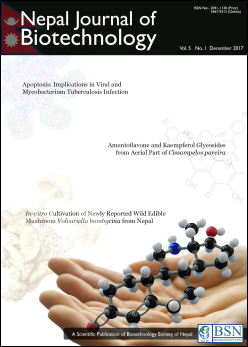Analysis of Phytoconstituents and Biological Activities of Different Parts of Mahonia nepalensis and Berberis aristata
DOI:
https://doi.org/10.3126/njb.v5i1.18864Keywords:
Mahonia nepalensis, Phytochemical, Berberis aristata, LC50 valuesAbstract
The phytochemicals and biological activities of extracts from leaves and stem of Mahonia nepalensis and Berberis aristata were carried out. Phytochemical screening showed the presence of alkaloids, steroids, polyphenols, quinones, glycoside, flavonoid, terpenoid and cardiac glycoside in the hexane, ethyl acetate and methanol extracts of leaf and stem of these two plants. The column chromatography of methanol extract of stem of Mahonia nepalensis resulted in isolation of four pure compounds MN1, MN2, MN3 and MN4. Out of four isolated compounds, two were identified as MN1:b- sitosterol and MN2: Berberine by comparison of melting point, Co-TLC, IR and UV spectra of authentic sample. Potent pharmacological activity of Mahonia nepalensis and Berberis aristata were revealed from antimicrobial activity and brine shrimp bioassay. Methanol extracts of stem of Mahonia nepalensis and Berberis aristata showed significant zone of inhibition of 18 mm and 21 mm respectively against the Staphylococcus aureus. Methanol extract of Berberis aristata were comparatively little stronger against Staphylococcus aureus than methanol extract of Mahonia nepalensis. LC50 values (μg/ml) of methanol extracts of stem of Berberis aristata and Mahonia nepalensis were found to be 8.058x10-4 and 8.3 whereas methanol extracts of leaf of Mahonia nepalensis and Berberis aristata were 389.04 and 1303.166 respectively.
Nepal Journal of Biotechnology. Dec . 2 0 1 7 Vol. 5, No. 1: 5-13
Downloads
Downloads
Published
How to Cite
Issue
Section
License
Copyright Notice:
The manuscript submitted to NJB must be an original contribution, not previously published and should not be under consideration for publication elsewhere. When the manuscript is accepted for publication, the authors agree to automatically transfer the copyright of the article to the publisher. It should grant permission to any third party, in advance and in perpetuity, the right to use, reproduce or disseminate your article, according to the NJB copyright and license agreement.
Authors transfer copyright to the publisher as part of a journal publishing agreement but have the rights to: Share their article for Personal Use, Internal Institutional Use and Scholarly Sharing purposes, with the NJB applies the Creative Commons Attribution-NonCommercial CC BY-NC license to all the works we publish after Jun 2020 (Before it was CC BY-NC-ND). Under this license, authors agree to make articles legally available for reuse, without permission or fees, for virtually any non-commercial purpose. Anyone may remix, adapt, and build upon your work non-commercially, and although their new works must also acknowledge you and be non-commercial, they don’t have to license their derivative works on the same terms. More details on CC BY-NC refer to its Licence Deed and Legal Code.






